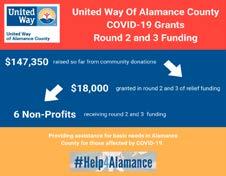
14 minute read
ALLIED CHURCHES of Alamance County
housing the homeless, feeding the hungry
In October of 2018, there was an article published in the local newspaper indicating that the long-standing agency, Allied Churches of Alamance County, Inc. (ACAC) would be closing their doors soon due to lack of financial support and faith in the agency’s mission. The community became concerned and there were several meetings and a task force developed to see what could be done to save the shelter. The future of assisting the homeless population was at stake.
As time progressed and meetings were held, things began to change for the better.
ACAC began reworking its programs and customer service. Under the leadership of Jai, small gains were seen and the community started to provide more and more support. While things were changing for the shelter programmatically, the next step was to stabilize and increase the financial stance of the agency.
United Way of As Executive Alamance County, The Jai Baker, along with his support staff, took stock of Director, Jai engaged Board of Directors of things and a fresher vision emerged with (and met with) Allied Churches and local civic and social community stakeholders gathered to In the process, the Board of organizations to listen intently as to create a task force to save and assist Directors named Jai Baker as why organizations were not willing Allied Churches. The Board of Direc- Interim Shelter Manager, later to to contribute to this necessary cause, tors and the Task Force had to make be named Executive Director. and he wanted to know how he could some tough decisions around staffing change their perception of Allied and services provided. Churches in a way that might compel them to want to help.
and the future looks brighter...
Over the course of this process, many other churches were visited and many “Moments for Mission” talks were had. Through these efforts, ACAC started to feel a momentum shift in its ability to meet its budgetary goals.
The future looked brighter!
CHANGING WITH THE TIMES
ACAC dug in and revamped its programs, focusing on a model that would impact what is now “coined” as When the community learned that Allied Churches was potentially going to close its doors " due to lack of funding in October 2018, there was a huge outpouring of voices saying, 'We can't let this happen!' And they were correct. With so many concerned people, you would think the financial support would be there, too. United Way joined forces with the Allied Churches Board to support the leadership of Jai Baker as the new Executive Director and give him the reins to lead Allied Churches. United Way provided technical
the Barriers to Housing. ACAC identified five core areas they needed to concentrate on in order to better serve their clients: • Employment • Education • Health and Mental Wellness • Family Dynamics • Access to Housing
As this model took root, the positive outcomes were soon evident.
Heidi Norwick, President of The United Way of Alamance County had this to say about the resurgence and work that ACAC provides to the community. support and coaching to staff, as we believed in the future potential of Allied Churches. Under Jai's leadership, Allied Churches has emerged as a thriving, effective and efficient non-profit that serves its mission to house the homeless and feed the hungry. “ “All the world's a stage, and all the men and women are merely players: They have their exits and their Entrances.” Jai came to Allied Churches with 20+ years of service with The Department of Corrections. Jai has a passion for helping others better themselves by providing a “Hand UP” to those in need. Jai is a leader in many Local and National Fraternal and Civic Organizations. He is a true believer that all things will get better in time and that every day is a new day and we should be glad in it. Jai is a Husband, Father and mentor to many that he meets. When you come to the shelter, you never know where you’ll run into Jai, has a knack for being everywhere at once!

—Jai Baker, Executive Director Allied Churches of Alamance County (336) 229-0881, Extension 113 jbaker@alliedchurches.org
vision & focus
Today, ACAC remains a vital part of Alamance County. During these uncertain times ACAC has been able to provide rental and utility assistance, as well as over 100,000 lbs of food, to county residents in the past two months. ACAC also operates an emergency shelter, offering job and education-related services, meals and emergency food at their community kitchen fondly named “Joe’s Diner,” where everyone is welcome. You will always see friendly faces and local business people there as well.

ACAC continues to thrive and flourish during these times of the pandemic. It continues to assist individuals in their housing efforts. ACAC has built a robust portfolio of apartment complexes and private homeowners that work with ACAC and the individual to provide a safe and comfortable place for them to start again.
In the coming months, ACAC will continue to focus on making sure that an individual works toward attaining self-sufficiency. ACAC has developed the resources to ensure that through case management and Tenant Education and Orientation Classes (TEOC) an individual will be equipped with all the tools one needs to live a life that no longer means being homeless. These classes and programs were developed by long-standing employees Monika Gauthier, Sabrina Corbett and Emily Stevens.
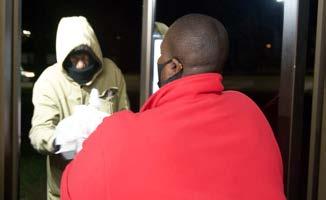
The new vision and focus of service delivery has proven to be just what Alamance County needed! ACAC's end-of-year reporting was something unexpected: ACAC ended the fiscal year with 90% housing success rate, and a stat that is important to Jai, which is that 86% of all residents of ACAC secured employment with 14 days of being enrolled in the shelter.
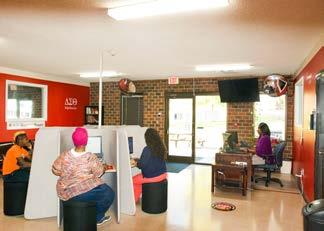
This is amazing progress and so inspiring to all who support and participate in Allied Churches' efforts.
Whether it's fighting homelessness, preparing delicious meals or just offering some encouraging words, ACAC is fulfilling its mission and it truly believes the best is yet to come.
the best is yet to come
OUR DOORS ARE ALWAYS OPEN — TO THOSE IN NEED AND TO THOSE WHO CAN HELP
VOLUNTEER
ACAC relies on volunteers to help with the many needs of people looking for help. The facility is always in need of volunteers for everything from filing papers, handling phone calls and food pick-up to stocking shelves in the Food Pantry.
If you are interested in volunteering, you can do so by filling out an online form at: alliedchurches.org OR call (336) 229-0881 for more information.
WHAT YOU CAN DO
The program relies almost entirely on donations of food, funds and supplies from local individuals, community organizations and churches, while volunteers provide the labor needed daily to run the kitchen.
Until the cycle of poverty and homelessness is broken, ACAC relies on you — neighbors and friends — for financial support.
WHAT IS NEEDED
• Monetary and food item donations • Volunteers • Your unique skill set
"From the bottom of our hearts, thank you (in advance) for the gift of your time"
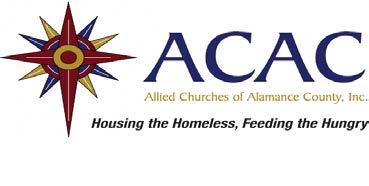
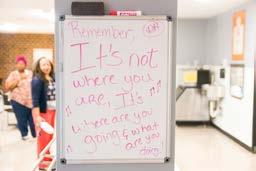
Allied Churches of Alamance County 206 N Fisher Street Burlington NC 27217 (336) 229-0881 alliedchurches.org OPEN 24 HOURS

When the North Carolina Railroad decided to build its repair and maintenance facilities in Alamance County, it hired Colonel John Harden of Graham to clear the site. One of those accompanying Colonel Harden as part of his work crew was a 21-year-old blacksmith, Barney May, who made metal reinforcement bands for wheels on the carts used to move the dirt and debris. He proved to be such a capable blacksmith that he was hired by the railroad at what became known as “Company Shops” and worked there until they closed.
All of Barney’s sons eventually worked for the railroad, but the best known was his oldest child, Henderson Rufus May, who was nicknamed “Hense.” He was born in Company Shops on January 16, 1858 and went to work for the railroad doing odd jobs shortly before he turned twelve years old. In about 1882, Hense was hired as a locomotive fireman.
In 1885, William H. “Will” Turrentine resigned as superintendent of the railroad’s maintenance shops and was replaced by Joseph C. “Joe” Holt, who had formerly headed up the carpentry shop. Joe liked Hense May and later that year promoted him to engineer on a branch line that ran from the main line to Chapel Hill, which the university students called the “ShooFly” train.
It was there in Chapel Hill that Hense met his future wife, Margaret “Maggie” Cheek, and he married her on June 13, 1887, shortly after he was promoted to engineer on the main line. Company Shops had been renamed “Burlington” just a few months before Hense and Maggie married and they lived there in a one-story house located at 315 East Morehead Street, eventually having four children. Hense May had two habits as an engineer that everyone remembered. Those living in town at the time recalled that he always blew extra blasts of the train’s whistle (two longs and two shorts) whenever he was nearing the Burlington crossings. A second habit, which no one but the firemen who worked with him ever noticed, was that he couldn’t keep his hands off the “squirt gun,” which injected water into the boiler to keep it at the proper level. The control was normally operated by the fireman, who sat in the left-hand seat; however, there was a spare set of controls on the engineer’s side on the right, and Hense must have always doubted his fireman’s ability to use the “squirt gun” properly because he was always manipulating it himself.
Hense is known to have had only one major tragedy during his career as an engineer. On Tuesday, August 6, 1895, he was taking a special excursion train with a group of firemen from Winston-Salem and Greensboro to a tournament
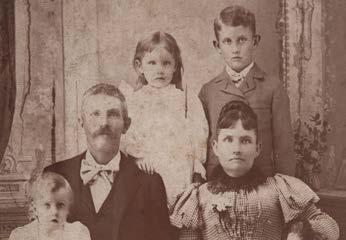
in New Bern. When he rounded the curve going from Burlington to Haw River at about 10:00 a.m., he noticed an east-bound freight train still partly on the main line and east end of the bridge. It was supposed to have been off on a sidetrack so that the excursion train could pass. Hense instantly reversed the engine and put on the brakes, but knowing there was going to be a collision, he jumped from the cab to save his life. The locomotive plowed into the caboose and splintered it, as well as a boxcar in front of it. Some passengers riding in the caboose were slightly injured, but Edward W. “Ed” Durham of Chapel Hill was seriously injured. Both of his legs were broken, and he suffered a broken arm and broken collarbone, among other injuries. His right leg was amputated in an attempt to save his life, but he died the next morning. Hense’s career did not suffer as a result of the accident and he continued as an engineer for the next 14 years. In the first decade of the twentieth century, Southern Railway ran a train each day between Goldsboro and Asheville. Hense May was one of three engineers on the run between Salisbury and Goldsboro. One day he would make a run between Salisbury and Goldsboro, and the next day he would make the run from Goldsboro to Salisbury. Thus, he could spend every third day back in Burlington with his family.
At the end of 1909, Hense May came down with pneumonia and then developed typhoid fever on top of it.
Henderson "Hense" Rufus May died January 12, 1910, just a few days before his 52nd birthday. He was buried in Pine Hill Cemetery on January 13.
Henderson "Hense" Rufus May
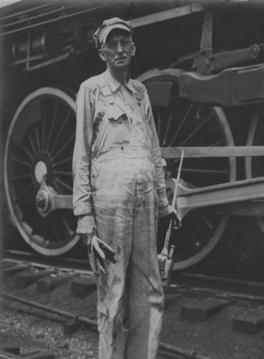
WALTER BOYD contributor
Attorney and native of Burlington, North Carolina, Walter Boyd developed an interest in Burlington’s history at a very young age. As a child, he often interviewed people and collected old photographs and documents, which led to his fondness for writing about Burlington’s rich history.
Over one hundred years ago, in late April 1913, automobile began to supplant the horse a few years, later they Burlington’s Democrats had a meeting to nominate a abandoned their livery business and became wholesale grocers. candidate for the office of mayor. Ed Moore was re-elected mayor of Burlington two more It seemed that everyone had a different favorite and times — in 1915 and 1917. At the beginning of his second term among those nominated were Leslie Meador, Archippus he became the city’s first full-time mayor. His salary was raised “Chip” Barrett, John Henry Vernon, James Alexander “Jim” to $100 per month, and free food was provided for his horse, Turrentine, Henry “Hen” Kime, James Marshall Browning, but he was expected to devote full time to the office. and Richard Allen “Dick” Freeman. Finally, Rev. James During Ed’s first term, Burlington’s City Hall was located David Andrew, pastor of the First Reformed and Evangelical on the second floor of a two-story brick building erected by his Church (who would soon become brother Sam at the corner of South Worth president of Catawba College), and West Front streets. (That building is nominated 39-year old James Edwin best known today as the original location “Ed” Moore, a wholesale grocer. Ed of Zack’s.) At the beginning of his third won the Democratic nomination on term, however, Ed moved into a new City the third ballot and went on to win Hall, located just across the street, which the election held on May 6, beating served Burlington for more than 50 years. incumbent Joseph H. “Joe” Freeland Although Ed Moore was considered by 190 votes. to be one of Burlington’s best and most Ed was born near the village of Alamance on Aug. 30, 1873, the We've come a long way, baby! progressive mayors, when the Democrats got together on April 24, 1919 to name a second of three sons of David Matthew Moore and the candidate for the next election they did not pick him. He lost former Olivia “Mittie” Perry, but the family soon moved to a the nomination by four votes to Earl Baynes Horner, who went farm near Saxapahaw and that’s where he was raised. He was on to win that election (and every subsequent mayoral election well-schooled for the time, completing his education at Dr. until his death in 1944). After Mayor Horner’s 25-year “reign,” William Thornton Whitsett’s Fairview Academy. Burlington switched to its present council-manager form of Around the beginning of 1897, Ed’s father and two government. brothers moved to Burlington and established “D. M. Moore Ed died on June 27, 1932. The only remnant of the Moore & Sons,” a men’s clothing store at what is now 138 East family in downtown Burlington today is the original D.M. Davis St. Ed was reportedly reluctant to move to Burlington Moore & Sons building at 138 East Davis St. David Moore because he had started his own store in Saxapahaw and died on Jan. 15, 1916, and a little over three years later his was doing quite well. He also had a sweetheart there, Mary sons decided to close the store. It has housed a large number A. “Mamie” Holt, the daughter of Isaac and Josephine of businesses since then and was most recently a coffee shop. Thompson Holt. He married her on June 19, 1898, and they The second floor for over 50 years was the photography studio had two children: Grace (who later married Reid Maynard, of Ed Moore’s brother-in-law, John Anglin. It was originally who would become a noted local hosiery magnate), born in operated by Richard Kelly Davenport, Grover Moore’s brother1900, and Edwin, born in 1906. in-law, as “Davenport Studio,” but after he decided to study for Eventually, Ed’s older brother, Samuel G. “Sam” Moore, the ministry in 1909, John Anglin left Graham and came to persuaded him to come to Burlington. While their young Burlington to take it over. brother Grover continued working in their father’s store, Sam and Ed branched out and formed “S.G. & J.E. Moore Livery” around the end of 1898. It was located on West Front Street, about where Boston Sandwich Shop is now. The original WALTER BOYD contributor Attorney and native of Burlington, North Carolina, Walter Boyd developed an interest in Burlington’s history at a very frame building was replaced with a new brick structure young age. As a child, he often interviewed people and collected around 1910 (which burned Nov. 25, 1935). When the old photographs and documents, which led to his fondness for writing about Burlington’s rich history.
Are you a new local business? "BURLINGTON Are you a local business who has learned to do business in a new way during these times? STRONG" WE WANT TO TELL YOUR STORY
JoinJoinJoin the the the movement movement movement

APPLY ONLINE
ENROLLMENT NOW OPEN
find out how your business can join forces with other local businesses and be featured on the cover of Burlington Magazine ' s upcoming issue BURLINGTON STRONG




